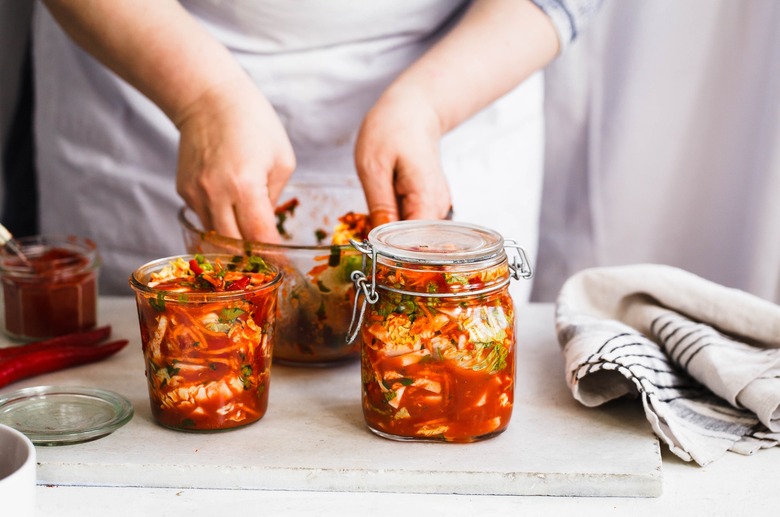Heal Your Gut Naturally By Fermenting Foods At Home
Kombucha, sauerkraut, and kimchi are just a few of the buzz-worthy fermented products on supermarket shelves. With their sharp flavors and distinct feel, they're often a top choice for those looking to boost their gut health and aid their digestion. However, store-bought versions of these products can get pricey and could potentially come with additives and preservatives that harm the very gut health you were looking to heal.
The Daily Meal, in pursuit of a more natural solution, contacted Jordan "Uri" Laio of Brassica & Brine, a fermentation expert who crafts his own fermented foods, who partnered with Kevita to create a simple, five-step guide to explain how he makes his craft products. Laio illustrates brilliantly just how easy it can be to make delicious, fermented foods without spending an arm and a leg for palatable flavor.
Here's his Fermentation 101, a guide to making your own sauerkraut that almost anyone can do.
First, we will start with what you will need materials-wise:
- Cutting board
- Knife
- Large bowl
- 32-ounce jar with lid
- Airlock (or home vegetable fermentation kit like RLM Provisions' Lactofermentation Kit, Pickl-It, Easy Fermenter, Pickle Pipe, etc.)
You will also need these three ingredients:
- One medium to large cabbage, preferably organic and locally grown
- 1 tablespoon sea salt
- 1 teaspoon of each spice of your choice (Note: Traditional spices include caraway seed, mustard seed, dill, garlic, bay leaves, and juniper berries.)
Directions:
1. Set aside one full leaf of cabbage. Then, chop the remaining cabbage in half from top to bottom and cut out the core. Discard the core.
2. Shred the cabbage by cutting it into thin ribbons or running it through the shredding blade on a food processor.
3. Add salt (and optional spices) to the shredded cabbage and knead the salt and shredded cabbage for 1 to 2 minutes.
4. Let the cabbage sit and "sweat" for about 15-30 minutes (or longer) at room temperature. The salt will draw out a lot of moisture from the cabbage, creating the beginnings of a brine, and the mix will become noticeably wet.
5. Pack the cabbage mixture into your jar. As you fill in every couple inches, give it a forceful push down with your fist or other tool. Stuff the cabbage with its brine into the jar as tightly as you can, pushing out any air pockets and filling to within an inch of the lid. Place the reserved full leaf of cabbage on top, crumpled up, and then screw the lid on loosely so that pressure can escape during fermentation.
After you complete these five steps, all you have left to do is wait.
Place your jar on a plate to catch any overflowing brine, which will likely leak from the jar as fermentation progresses.
You want to place your jar in a cool place (ideally 65 to 75 degrees) and out of direct sunlight.
Keeping the five-step theme alive, you will let your jar sit for at least five days before it's ready. You can leave it for as long three weeks if you prefer — just move the whole jar to the refrigerator when you decide it's done.
Here's what you should expect during the fermentation process.
During the first few days, it will bubble and become fragrant, the colors will dull, and the flavor will develop an acidic edge. All of this is normal — be patient for the full process of fermentation and you'll have a sharp, flavorful addition to your meals.
This sauerkraut should be fine for at least six months to a year, if not longer. Your nose and taste buds will tell you if it's gone bad.
Gut health doesn't have to be expensive, and it doesn't have to involve pills. Adding sauerkraut to your diet is a great way to keep your good gut bacteria in check. For other foods as good for your gut as probiotics, click here.
